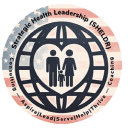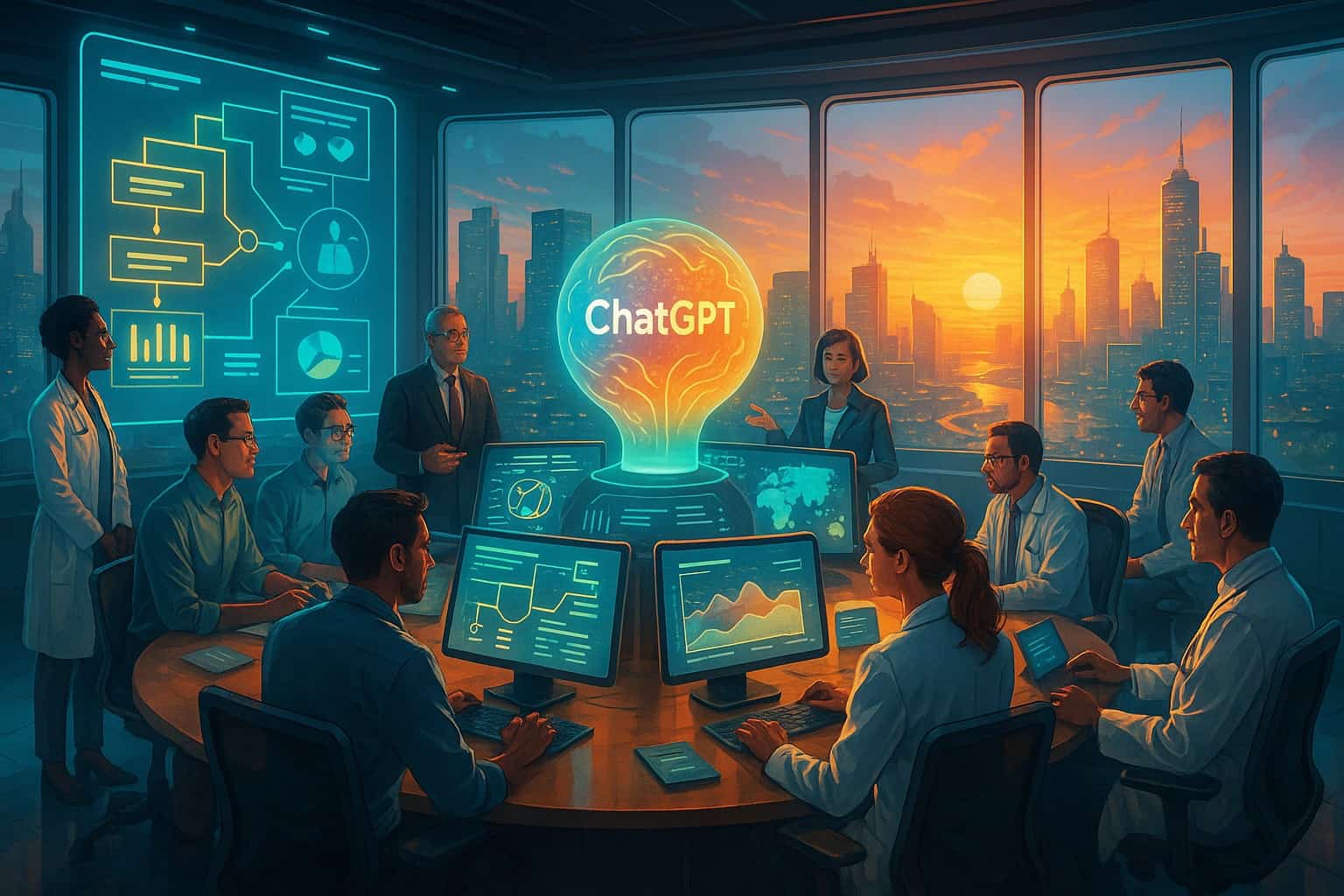Are you leading your team through bureaucracy—or letting it lead you?

Learn how ChatGPT accelerates reimbursement strategies and transforms payer engagement.
Executive Summary: AI isn’t replacing health leaders—it’s amplifying them. Administrative red tape, not clinical innovation, is the true healthcare bottleneck, as shown in the LINK device case study. Within hours, rather than months, ChatGPT can transform reimbursement hurdles into approval strategies with the help of disciplined oversight. How can upstream leaders organize inputs, create documentation that complies with regulations, and scale this approach to other service lines? That is the question this article seeks to answer. It’s a repeatable blueprint for driving efficiency, compliance, and innovation. To learn more, use the links, questions, learning activities, and references.
Table of Contents
Author’s Note: The “real world” case study, “SHELDR–LINK Device Reimbursement Challenge and AI-v6” (Aug 2025) (Real World Case, Case Study, Instructor Guide) Available Upon Request)provides a replicable model for applying ChatGPT to any healthcare reimbursement or coding barrier, not just the LINK compression-fixator example. The key insight is that when a problem is framed correctly, AI can turn weeks of scattered research and drafting into a single coordinated workflow that yields compliant templates, advocacy materials, and approval roadmaps in hours—not months.
Introduction – Stop Waiting for Codes, Start Building Them
Innovation without reimbursement is like building a plane with no runway. Every week, promising technologies—AI tools, remote monitors, home-care devices—hit a bureaucratic wall.
The problem isn’t medicine. It’s the system. Current Procedural Terminology (CPT) codes lag behind clinical reality (AMA). For example, Category III codes are designed for emerging services but don’t guarantee payment—and converting to Category I is long. The LINK case study exposed this dysfunction and offered a clear solution: use AI to turn complexity into strategy.
In that case, ChatGPT didn’t replace experts; it organized their chaos. Within days, a physician’s complaint became a complete establishment of a coding roadmap—letters, cheat sheets, payer scripts, and a CPT action plan. The takeaway: any leader can replicate that success across digital health, behavioral care, or chronic disease management. The new leadership question isn’t “Can we afford AI?” It’s “Can we afford not to?”
Frame the Problem Like a Mission Brief
The NIH article from National Library of Medicine, Artificial Intelligence In Healthcare: Past, Present And Future highlights how automation and machine learning can improve clinical care with data extraction from electronic health records. It warns that inconsistent data input and lack of validation cause billing errors, underscoring the need for human oversight in AI-assisted systems. Coding is no exception. Every broken coding process starts the same way—denials, vague payer emails, and confused staff drowning in acronyms. AI doesn’t fix disorganization; it only amplifies scale.
When you feed it chaos, you get amplified chaos. The LINK team succeeded because they gave ChatGPT structured context: the device description, current codes, payer restrictions, and the desired outcome. Clear inputs. Structured mission. Strategy emerged.
For example, AI tools can automatically extract LINK procedure details from operative notes, propose CPT codes, and alert coders to mismatched documentation—such as identifying when “closed fracture repair” was miscoded under “open reduction” CPT categories.
Leaders must demand that same clarity. One paragraph should define the challenge. If it takes a ten-page email chain, you don’t have a reimbursement issue—you have a communication issue. ChatGPT acts like a mission planner: when you feed it precision, it returns strategy. When you feed it noise, it returns noise. “Garbage in, garbage out.” Ask yourself: can your team summarize your most significant barrier in one paragraph—or will AI drown in your disorganization?
This principle is backed by research: AI and ChatGPT functions best when input data is clean, contextually framed, and human-reviewed. Without that, you’re handing the co-pilot the wrong route.
Generate a Tiered Strategy in One Workflow
The original case demonstrated that ChatGPT, with a single prompt, could produce an entire advocacy package—letters, scripts, stakeholder maps, and a detailed timeline. Imagine replacing months of committee meetings with one coordinated AI workflow. This “tiered strategy” works across every Health and Human Services (HHS) sector:
- Immediate fixes: unlisted-code workarounds and modifier strategies for compliant billing.
- Mid-term solutions: payer education, cost comparison sheets, and specialty-society engagement.
- Long-term strategy: Category III CPT code submission, Healthcare Common Procedure Coding System (HCPCS) applications, and eventual Category I conversion.
Each layer builds on top of the one before it, making a runway for speed instead of a roadblock. AI doesn’t guess; it sets things up. ChatGPT turns what leaders want into tactical tasks that need to be done by a certain date. Would you put your next round of funding on handwritten letters or an advocacy engine that uses AI?
In fact, studies show that reimbursement for new technologies often stalls at the early coding stage—for example, device manufacturers cite Category III conversion delays as a significant barrier. Building this layered approach gives you structure, not chaos.
Use ChatGPT as Your “Junior Analyst,” Not Your Boss
Deloitte’s 2024 analysis emphasizes that generative AI can streamline documentation, automate claim submissions, and accelerate coding validation when governed responsibly. However, without data integrity and compliance oversight, it amplifies existing administrative errors. The report urges structured frameworks linking AI use directly to coding accuracy, auditability, and payer transparency.
AI writes quickly. When I decided to use ChatGPT to address the clients problem, I was able to create and present faster, cleaner drafts and options—verified in hours, not weeks
You can think of ChatGPT as your young policy analyst. It instantly processes huge amounts of data but doesn’t have any human context. You are in charge of leading, reviewing, and taking responsibility for the outputs.
Every organization using AI for policy or coding must establish governance to:
- Shape the problem.
- Verify checkpoints for compliance and accuracy.
- Achieve final sign-off by credentialed leaders and stakeholders.
- Create audit trails documenting how AI-assisted drafts were refined.
In the end, people decide what’s right. It’s not authority that gives ChatGPT its power, but speed. Easy rule for the LINK project: AI writes the drafts, and experts decide what to do. Before releasing the report, leadership checked every policy citation, every coding sequence, and every clinical claim.
Also, AI governance isn’t bureaucracy—it’s protection. Without it, speed becomes risk. Research in AI reimbursement notes that without human oversight, adoption may lead to cost escalation and misalignment with policy goals. Would you let automation file your CMS submission without reading it first?
Scale the Playbook Across Service Lines
The brilliance of the LINK case wasn’t the device; it was the process. Once the workflow proved reliable, it became transferable. Replace “external fixator” with “telehealth monitoring,” “digital mental-health therapy,” or “wearable cardiac sensor.”
Every health leader can adapt this same AI framework to new contexts:
- Identify the coding gap.
- Build the economic and clinical argument.
- Generate payer-ready communications.
- Map a pathway from provisional to permanent reimbursement.
That’s not automation—it’s replication. The result? A reusable internal “AI Approval Lab” that supports every innovation from pilot phase to full payer adoption. You can’t scale good intentions. You can scale good processes.
Recent literature on AI in billing and coding supports this: organizations using AI to automate workflows reduce denials, improve accuracy, and free staff to focus on higher-level tasks. If your operation still treats each new product as a unique scrambling event—stop. Build once, reuse often.
Accelerate Evidence and Engagement
Speed dies without evidence. ChatGPT doesn’t invent data; it structures it. The system can draft registry templates, track utilization, summarize outcomes, and prepare payer decks that update quarterly. In the LINK example, AI helped plan the evidence-generation process—what to measure, how to report it, and how to pre-empt payer objections. That’s proactive advocacy.
When an AMA or CMS panel convenes, leaders should arrive with audited data and precise visual analytics—not anecdotes. ChatGPT can summarize the literature, extract tables from public databases, and propose next-step research metrics. Evidence wins debates. Excuses don’t.
Moreover, policy research highlights the importance of value-based and outcome-based reimbursement models—especially for AI and digital health services. If you’re still arguing features, you’re already behind.
Would your current data strategy survive a one-hour payer panel grilling? Build it before you’re grilled.
Reduce Administrative Waste, Refocus on Leadership
Reimbursement paperwork is where leadership goes to die. Every letter, denial appeal, or payer deck written manually drains hours of high-value time. The LINK process flipped that ratio: AI drafted 80 percent; leaders refined 20 percent. Now imagine scaling that across your organization.
- Coders receive pre-structured templates.
- Clinicians get pre-filled justifications aligned with policy.
- Executives receive real-time dashboards showing approval cycle times and ROI.
When leaders reclaim time, they reclaim strategy. That’s not just efficiency—it’s a moral shift. You’re redirecting intellect from forms to patients. Stop managing paperwork. Start leading people.
Literature on AI in billing supports that automation of claim submission and error detection reduces denials and improves cash flow. The margin you reclaim isn’t just money—it’s leadership bandwidth.
The Broader Imperative: Governance, Not Gimmicks
AI isn’t a magic wand; it’s a mirror. It reflects the discipline—or dysfunction—of those who use it. Any AI integration into coding or reimbursement must follow governance principles. But you do need to prepare to leverage the power of AI to serve America’s healthcare needs. For example, with more than 150 million Americans enrolled in Medicare, Medicaid, and the Children’s Health Insurance Program, CMS possesses one of the most robust data portfolios in the federal government.
We house patient and provider claims, beneficiary enrollments, and medical records, along with internal data such as budget documents and contract records. AI will play a key role in leveraging all of this data to drive innovation and enhance operational excellence across our programs.
As defined by for the Department of Health and Human Services by the Assistant Secretary for Technology Policy, “AI enables computer systems to perform tasks normally requiring human intelligence.” AI can analyze data, automate labor-intensive processes, find operational efficiencies, provide business insights, interact with customers, make predictions, optimize service delivery, and reveal new ways of solving problems. In short, AI is an emerging technology that will revolutionize CMS operations and customer experience for the public we serve.
Establish a written policy that defines:
- Verification procedures.
- Ownership of final content.
- Continuous monitoring for bias or accuracy drift.
- Secure data handling compliant with HIPAA and CMS standards.
AI governance ensures that automation strengthens trust, not undermines it. Without that discipline, you risk regulatory exposure and reputational damage. True leaders treat governance as a strategic advantage, not an obstacle.
Recent communications in journals emphasize the need for stakeholder integration, evaluation frameworks, and incentive alignment for AI deployment in healthcare. If you skip governance, you’ll be drafting a crisis memo next—not a roadmap.
Build the Engine, Not the Exception
Every coding barrier solved with AI should produce a reusable model. Each template, letter, or payer script is intellectual property—your competitive edge. Document it, train your staff, and store it in your knowledge base. In six months, you’ll have an internal repository of prompts, workflows, and outcomes—a “SHELDR AI Playbook” customized to your system. Future leaders will measure performance not by how fast they respond to crises, but by how fast they repurpose previous solutions.
Remember: replication beats originality in the long term. One device reimbursement pathway isn’t a victory. A system of pathways is. Use the LINK case as your prototype, then iterate.
What Success Looks Like Six Months From Now
Here’s your scoreboard:
- Approval times cut by 50 %.
- Denial rates dropping as documentation quality rises.
- Staff using unified payer scripts, not ad hoc emails.
- Specialty societies engaged early in coding reform.
- Finance teams tracking cost savings and payer adoption.
- Leadership meetings focused on outcomes, not obstacles.
That’s what happens when governance meets velocity. It’s not science fiction—it’s disciplined execution.
Health Equity and Upstream Impact
AI-driven reimbursement reform goes beyond money. The issue is access. Underserved communities lose options when codes lag. Patients get affordable, timely care when leaders act. The LINK process shows that AI can close equity gaps by enabling office-based, lower-cost care without hospital infrastructure. That method could support rural telehealth or home-based chronic disease monitoring.
Reimbursement reform is health-equity reform. Upstream leadership connects both.
Leadership’s Role in the AI Era
McKinsey’s 2025 Tech Trends Report warns healthcare leaders that AI’s potential due to fragmented governance and limited interoperability. I would argue, coding and reimbursement potential remains largely untapped too. Organizations that embed structured oversight—linking generative AI outputs to coding validation and payer policy—achieve faster reimbursement cycles and fewer denials, turning complexity into competitive advantage. Here are a few examples:
- LINK Fixator: Structured AI workflows can transform “unlisted” CPT coding into payer-approved strategies through validated templates and stakeholder mapping.
- Telehealth Monitoring Codes: AI could standardize justification letters and crosswalk CPT 99091 to newer digital monitoring categories.
- Behavioral Health Services: Generative AI could align progress-note documentation with Category III CPT codes for remote therapy billing, reducing audit flags.
Strategic Health Leaders (SHELDR) must be AI-savvy translators to bridge technology and trust. The new health governance playbook requires data and dialogue literacy. No need to code. You must lead. This article isn’t about job automation. The goal is to multiply impact. If AI does the work, you do the mission.
Lead the Reimbursement Revolution: Build Your AI Blueprint Now
The healthcare system isn’t failing for lack of technology—it’s failing for lack of structure. The LINK device case proved that disciplined use of AI can compress years of bureaucratic delay into days of progress. Whether your challenge is CPT codes, payer approvals, or digital health validation, the exact blueprint applies: define the problem, generate tiered strategies, verify relentlessly, and scale success.
This isn’t automation—it’s acceleration. Upstream leaders must master AI workflows, not fear them. Reimbursement reform is leadership reform.
Challenging Question: Will you let outdated codes dictate your organization’s pace—or build your own runway for innovation?
Consider the discussion questions and learning activities, then check out these articles at the Strategic Health Leadership (SHELDR) website:
4 Awesome AI Medical Supply Chain Superiority Moves That Win Health Crises
Deep-Dive Discussion Questions
- In your organization, what’s the single biggest coding or reimbursement barrier, and how would you brief it in one paragraph for AI input?
- How do you ensure that when you deploy an AI-driven strategy for coding approval, human verification remains non-negotiable?
- What would a tiered strategy (immediate, mid-term, long-term) look like for your next innovation—and are you ready to execute it?
Professional Development & Learning Activities
- Mission-Brief Sprint: Draft a one-paragraph reimbursement challenge for your next innovation; bring it to your leadership huddle.
- AI Workflow Workshop: Using ChatGPT or similar, generate an advocacy package (letter + payer script + timeline) for one pilot service line.
Videos
- Hospitals and Health Systems Using AI to Secure Reimbursement (June 30, 2025) by William Chan, CEO Iodine Software – HIMSS TV.
- 2 in 3 Physicians Are Using Health AI—Up 78% from 2023 (February 26, 2025) by AMA (Tanya Albert Henry) – AMA News Wire.
- How AI is Revolutionizing Medical Billing and Coding (2024) by UTSA PaCE – Career Insider article.
Hashtags
#HealthLeaderAI
#ReimbursementRevolution
#CodingBreakthrough
#DigitalHealthStrategy
#UpstreamHealthInnovation




